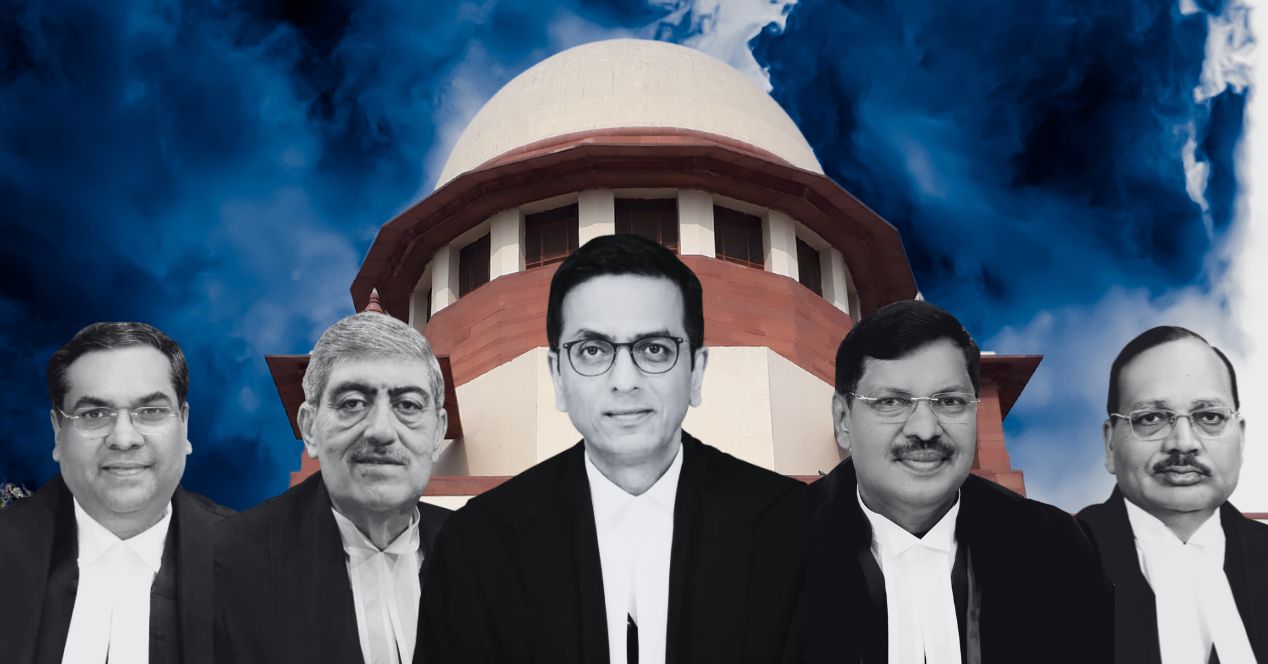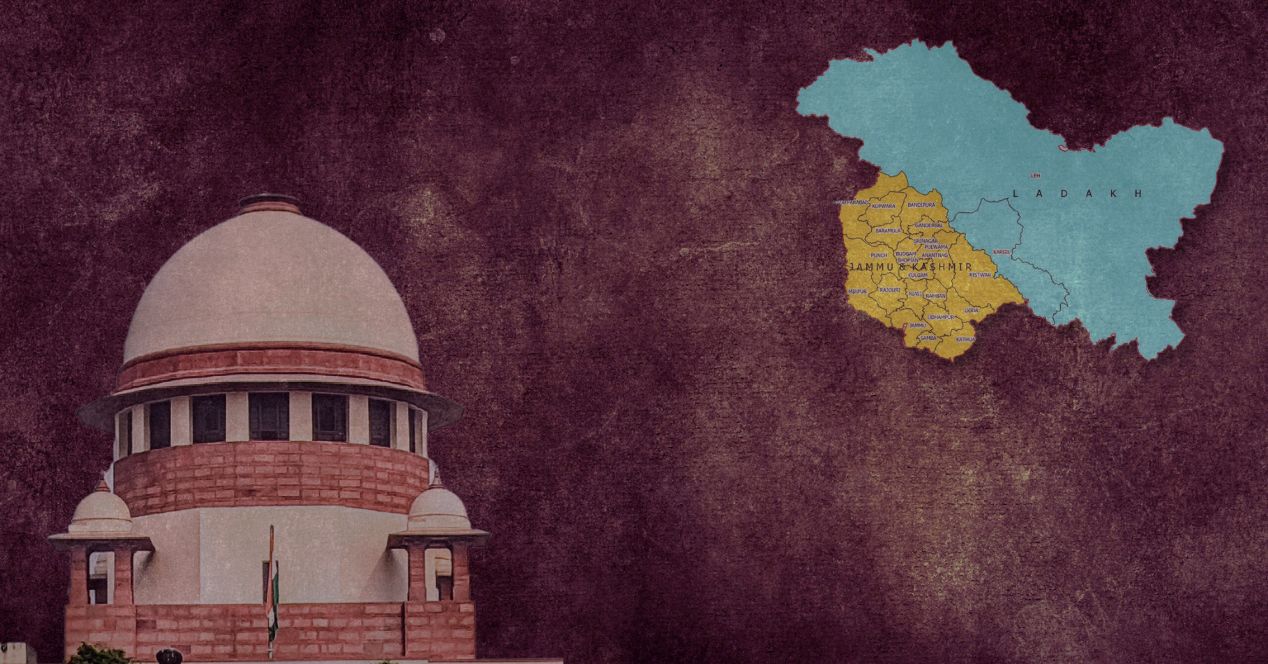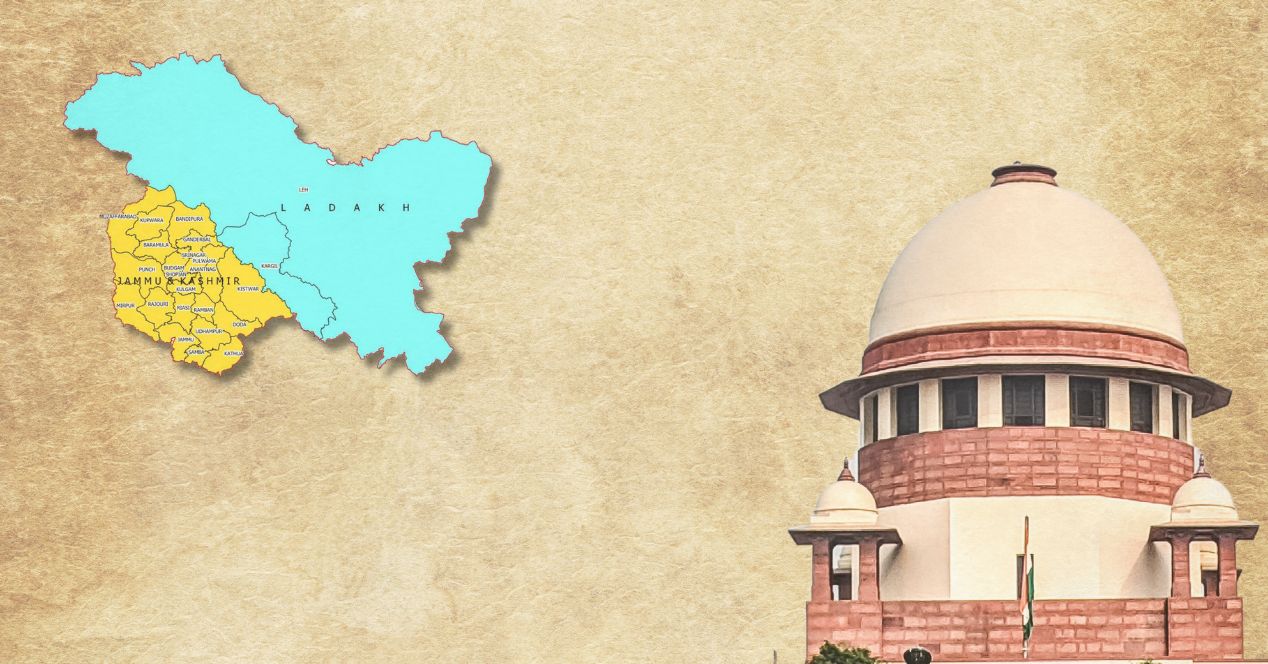Abrogation of Article 370 | Day 8: On reorganisation of J&K, misuse of President’s Rule and protection of minorities
Challenge to the Abrogation of Article 370Judges: D.Y. Chandrachud CJI, S.K. Kaul J, Sanjiv Khanna CJI, B.R. Gavai J, Surya Kant J
Today, the Bench heard arguments from Senior Advocates Dinesh Dwivedi, C.U. Singh, Sanjay Parikh and P.C. Sen. Through the day, the Bench nudged the Counsels to stick to their time limit, and avoid repetition of arguments. Though they were “not fatigued”, the judges warned that they were reaching “mental saturation” with the petitioners’ arguments and were keen to hear respondents’ views. Still, the Bench awarded an opportunity for two more petitioner advocates to argue tomorrow than planned. Though petitioners’ arguments were scheduled to end today, eight counsels remain to be heard from their side.
Continuing his arguments from August 17, 2023, Dwivedi argued that the accession of J&K to India was never one that stripped the state of all its powers. It was not a merger but an accession which came with the retention of internal autonomy and independence. Once this autonomy was expressed through the J&K Constitution, Dwivedi contended, all of Article 370 ceased to function.
Singh followed Dwivedi, and he focused on the reorganisation of J&K into the Union Territories of J&K and Ladakh. He argued that the Union had no power under Article 3 of the Indian Constitution to reorganise J&K. Even if it did, it could not have been done under President’s Rule.
Parikh, appearing next for the People’s Union For Civil Liberties, an NGO, highlighted J&K’s 1944 Manifesto, through which the people of Kashmir expressed their will to have a separate constitution for the state.
Lastly, Sen argued that though the majority of people in J&K were Muslims, they had chosen to join India. Article 370 was a form of a constitutional promise and thus must be strictly interpreted.
Background
Article 370 of the Constitution of India provided the State of Jammu and Kashmir with a special constitutional status. The provision substantially limited Parliament’s power to legislate for the State compared to other states.
On August 5, 2019, the Union government diluted Article 370, revoking Jammu and Kashmir’s special status. First, President Ram Nath Kovind issued presidential order CO 272. This Order allowed the Union to amend Article 370 without the recommendation of the Constituent Assembly.
Since J&K was under President’s Rule at the time, the powers of the Jammu and Kashmir Legislative Assembly were vested in the Union Parliament. So, a few hours after CO 272 was issued, the Rajya Sabha recommended the abrogation of Article 370 through a Statutory Resolution under Article 370(3).
On August 6, 2019, President Kovind issued a Proclamation, CO 273, putting the Rajya Sabha’s recommendation into effect. All clauses of Article 370 ceased to operate, except Clause 1 which was amended to state that the Constitution of India applies wholly to the State, removing the special status awarded to Jammu and Kashmir.
On August 9, Parliament passed the Jammu and Kashmir Reorganisation Act, 2019. This Act bifurcated the State of Jammu and Kashmir into two Union Territories—J&K and Ladakh.
Petitions were filed challenging the constitutionality of the dilution of Article 370 and the bifurcation of the State into two Union Territories.
On August 28, 2019, a 3-Judge Bench led by former CJI Rajan Gogoi referred the case to a 5-Judge Constitution Bench.
On October 1, 2019, 5-Judge Constitution Bench of the Court comprising Justice N.V. Ramana, S.K. Kaul, R. Subhash Reddy, B.R. Gavai and Surya Kant decided to hear the case from November 14th, 2013. The petitioners sought the case to be placed before a larger Bench. On March 2nd, 2020, the Bench refused to refer it to a larger Bench.
On July 3, 2023, the Supreme Court listed the matter to a Constitution Bench led by Chief Justice D.Y. Chandrachud. The Bench assembled on July 11, 2023 and decided to hear the challenge from August 2, 2023.
Dwivedi: All of Article 370 ceased to exist the moment J&K Constitution was adopted
Dwivedi explained that Article 370 was an interim arrangement because at the time that the Constitution of India was enacted, J&K had no Constituent Assembly or constitution. All the provisions in Article 370 about requiring consultation or concurrence were meant to be temporary until the J&K Constituent Assembly came along. Article 370 ceased to function once the Assembly framed the J&KConstitution.
The Bench resisted this argument. Chief Justice D.Y. Chandrachud pointed out that if this view was accepted, the Court would effectively be stating that the Constitution of India stood “frozen” after 1957, the year the J&K Constituent Assembly was dissolved. It would mean that India had no power to apply parts of its constitution to the state.
Justice Khanna noted that Dwivedi’s argument “cut through” the points made by the petitioners. Other counsels for the petitioners had argued that after the Constituent Assembly dissolved in 1957, Article 370(1) would apply and the other provisions of Article 370 would have served their purpose. In contrast, Dwivedi suggested that the whole of Article 370 did not exist from 1957. “Since 1957, so many Presidential Orders under Article 370 have been passed,” Justice Kaul remarked, “Had no one thought about this?”
In response, Dwivedi suggested that all laws passed in relation to J&K since 1957—Presidential Orders, and the application of several provisions of the Indian Constitution to J&K—got their legitimacy from the J&K Constitution itself. The accepted agreement between India and the state was that no one “from the outside” may make laws for J&K.
Wrapping up his arguments, Dwivedi stated that if two views are possible, the Court ought to choose the one that is in line with the J&K Constitution, and respects the autonomy of the state.
Singh: President’s Rule is to restore democracy, cannot be used to dissolve statehood
Singh focused his arguments on the reorganisation of J&K. He submitted that the presidential proclamation of December 19, 2018 which removed the two provisos of Article 3, applicable to J&K, was invalid and unconstitutional. “The purpose of 356 is to restore democracy,” he exclaimed. The President could not alter the status of J&K, even if the state was under President’s Rule. The Chief added to this, saying that the object of any proclamation under Article 356 can only be to ensure that the government of the state is carried on in accordance with the provisions of the Indian Constitution.
Singh argued that the apex Court has recognised that the President’s powers under Article 356 were limited and not absolute in cases such as S.R. Bommai v Union of India (1994), Rameshwar Prasad v Union of India (2006) and Madhav Rao v Union Of India (1970).
CJI Chandrachud asked Singh if his argument on the illegality of reorganisation of J&K could exist independently of the abrogation of Article 370. In other words, would the decision of the Court on the Reorganisation Act be unaffected by the Court’s decision on the validity of the abrogation? Singh agreed with what the Chief seemed to be suggesting. He insisted that his contentions had little to do with Article 370. Instead, his focus was on powers under Articles 3 and 356.
Singh: History shows that states were never meant to be downgraded to Union Territories
Singh took the Bench through the provisions and footnotes of the Government of India Act, 1919 which, according to him, was the precursor to Article 3. In that legislation, states were divided into categories based on their relationship to the dominion of India. The first category was the ‘Governor Provinces’, which includes states like Bombay. The second category covered the states that had acceded to India. ‘Commissioner Provinces’, which later became Union Territories, made up the third category. Other territories were the fourth category.
According to Singh, the progression since the 1919 Act has been “towards greater self-governance in the form of statehood”.
Parikh: The will of the people of J&K, as expressed in the Manifesto of 1944, cannot be ignored
Parikh focused on J&K’s 1944 Manifesto, popularly known as the Naya Kashmir Manifesto, which he claimed was a significant historical document.
Parikh informed the Bench that the Manifesto suggested that the people of Kashmir had come together to express their desire to remove monarchy and have a democratic constitution. The document was given to the Maharaja and “was translated ultimately to the Constitution.” A written Constitution, Parikh contended, was “supreme” and could not be ignored as it was a sign of sovereignty. Therefore, J&K retained its sovereignty or autonomy, unlike other states.
Next, he focused his arguments on Article 370 and submitted that this provision could be interpreted on the basis of three documents: India’s Constituent Assembly Debates, J&K’s Constituent Assembly Debates and the judgement of the Supreme Court in Prem Nath Kaul v The State Of Jammu & Kashmir (1959) which held that parliamentary and presidential powers under Article 370 was subject to the final decision of the J&K Constituent Assembly. According to Parikh, all three documents made it clear that the Union envisaged a Constituent Assembly and a constitution for J&K.
Sen: India is evolving towards inclusion, must protect the rights of the Muslim minority
Senior Advocate Prashanto Chandra Sen was the first counsel to discuss the demographics of J&K in detail. He noted that the people of Kashmir had the choice of “either being a majority in Pakistan or choosing to take a minority status in India”. By choosing the latter, they had demonstrated “conscious choice to remain a minority”. He argued that there was a constitutional promise to protect this minority in the form of Article 370. This context therefore favours a strict interpretation of the provision.
Citing V.P. Menon’s book Integration Of The Indian States, he noted that Lord Mountbatten felt that it was important to take the will of the people into account, given the religious demographic of the region. Further, Sen pointed out that “the Government of India had no territorial ambition” in Kashmir, and would have “left Kashmir alone” had it not been under attack from Pakistan. Sen read excerpts from A.G. Noorani’s book A Constitutional History of Jammu and Kashmir to show that “the accession was legally made by the Maharaja of Kashmir and the step was taken with the advice of Sheikh Abdullah”, then Prime Minister of J&K. Sen argued that this history was crucial to understand how Article 370 must be interpreted.
In S.R. Bommai v Union Of India, Sen noted, the Supreme Court said “federalism in the Indian Constitution is not a matter of administrative convenience, but one of principle, the outcome of our own historical process and a recognition of the ground realities.” Sen argued that the history of Kashmir showed that it was a “conscious choice” to accede to India, which had to be respected and protected. Since India was “moving towards a more inclusive society”, Sen suggested, repealing laws that offer protection against majoritarian laws for such a historically religious minority, would be a regressive step.
Adding to the arguments on the misuse of Article 356, Sen stated that before the abrogation of Article 370, in the SDG India Index Baseline Report, 2018, published by Niti Aayog, J&K had outranked several states on metrics like “peace, security, effective governance based on rule of law, upholding principles of equality”. In this context, he asked: “Where was the need for a 356?”
Eight more counsels for the petitioners will argue tomorrow, that is August 23, 2023.







